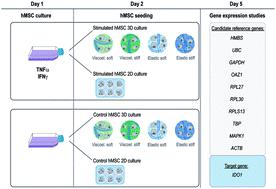当前位置:
X-MOL 学术
›
Biomater. Sci.
›
论文详情
Our official English website, www.x-mol.net, welcomes your feedback! (Note: you will need to create a separate account there.)
3D encapsulation and inflammatory licensing of mesenchymal stromal cells alter the expression of common reference genes used in real-time RT-qPCR
Biomaterials Science ( IF 6.6 ) Pub Date : 2020-10-26 , DOI: 10.1039/d0bm01562h Ainhoa Gonzalez-Pujana 1 , Irene de Lázaro , Kyle H Vining , Edorta Santos-Vizcaino , Manoli Igartua , Rosa Maria Hernandez , David J Mooney
Biomaterials Science ( IF 6.6 ) Pub Date : 2020-10-26 , DOI: 10.1039/d0bm01562h Ainhoa Gonzalez-Pujana 1 , Irene de Lázaro , Kyle H Vining , Edorta Santos-Vizcaino , Manoli Igartua , Rosa Maria Hernandez , David J Mooney
Affiliation

|
Human mesenchymal stromal cells (hMSCs) hold great promise in the treatment of inflammatory and immune diseases, due to their immunomodulatory capacity. Their therapeutic activity is often assessed measuring levels of expression of immunomodulatory genes such as indoleamine 2,3-dioxygenase 1 (IDO1) and real-time RT-qPCR is most predominantly the method of choice due to its high sensitivity and relative simplicity. Currently, multiple strategies are explored to promote hMSC-mediated immunomodulation, overlooking the effects they pose in the expression of genes commonly used as internal calibrators in real-time RT-qPCR analyses. However, variations in their expression could introduce significant errors in the evaluation of the therapeutic potential of hMSCs. This work investigates, for the first time, how some of these strategies – 3D encapsulation, the mechanical properties of the 3D matrix and inflammatory licensing – influence the expression of common reference genes in hMSCs. Both 3D encapsulation and inflammatory licensing alter significantly the expression of β-actin (ACTB) and Ubiquitin C (UBC), respectively. Using them as normalization factors leads to an erroneous assessment of IDO1 mRNA levels, therefore resulting in over or underestimation of the therapeutic potential of hMSCs. In contrast, the range of mechanical properties of the matrix encapsulating the cells did not significantly affect the expression of any of the reference genes studied. Moreover, we identify RPS13 and RPL30 as reference genes of choice under these particular experimental conditions. These results demonstrate the vital importance of validating the expression of reference genes to correctly assess the therapeutic potential of hMSCs by real-time RT-qPCR.
中文翻译:

间充质基质细胞的 3D 封装和炎症许可改变了用于实时 RT-qPCR 的常见参考基因的表达
由于其免疫调节能力,人类间充质基质细胞 (hMSCs) 在治疗炎症和免疫疾病方面具有巨大的前景。它们的治疗活性通常通过测量免疫调节基因的表达水平来评估,例如吲哚胺 2,3-双加氧酶 1 ( IDO1) 和实时 RT-qPCR 是最主要的选择方法,因为它具有高灵敏度和相对简单的特点。目前,正在探索多种策略来促进 hMSC 介导的免疫调节,忽略了它们对实时 RT-qPCR 分析中常用作为内部校准器的基因表达的影响。然而,它们表达的变化可能会在评估 hMSCs 的治疗潜力时引入重大错误。这项工作首次调查了其中一些策略——3D 封装、3D 基质的机械特性和炎症许可——如何影响 hMSC 中常见参考基因的表达。3D 封装和炎症许可都显着改变了 β-肌动蛋白 ( ACTB ) 和泛素 C的表达。UBC),分别。将它们用作标准化因子会导致对IDO1 mRNA 水平的错误评估,从而导致对 hMSC 的治疗潜力的高估或低估。相比之下,包裹细胞的基质的机械特性范围不会显着影响所研究的任何参考基因的表达。此外,我们将RPS13和RPL30确定为这些特定实验条件下的首选参考基因。这些结果表明验证参考基因的表达对通过实时 RT-qPCR 正确评估 hMSC 的治疗潜力至关重要。
更新日期:2020-11-03
中文翻译:

间充质基质细胞的 3D 封装和炎症许可改变了用于实时 RT-qPCR 的常见参考基因的表达
由于其免疫调节能力,人类间充质基质细胞 (hMSCs) 在治疗炎症和免疫疾病方面具有巨大的前景。它们的治疗活性通常通过测量免疫调节基因的表达水平来评估,例如吲哚胺 2,3-双加氧酶 1 ( IDO1) 和实时 RT-qPCR 是最主要的选择方法,因为它具有高灵敏度和相对简单的特点。目前,正在探索多种策略来促进 hMSC 介导的免疫调节,忽略了它们对实时 RT-qPCR 分析中常用作为内部校准器的基因表达的影响。然而,它们表达的变化可能会在评估 hMSCs 的治疗潜力时引入重大错误。这项工作首次调查了其中一些策略——3D 封装、3D 基质的机械特性和炎症许可——如何影响 hMSC 中常见参考基因的表达。3D 封装和炎症许可都显着改变了 β-肌动蛋白 ( ACTB ) 和泛素 C的表达。UBC),分别。将它们用作标准化因子会导致对IDO1 mRNA 水平的错误评估,从而导致对 hMSC 的治疗潜力的高估或低估。相比之下,包裹细胞的基质的机械特性范围不会显着影响所研究的任何参考基因的表达。此外,我们将RPS13和RPL30确定为这些特定实验条件下的首选参考基因。这些结果表明验证参考基因的表达对通过实时 RT-qPCR 正确评估 hMSC 的治疗潜力至关重要。


























 京公网安备 11010802027423号
京公网安备 11010802027423号